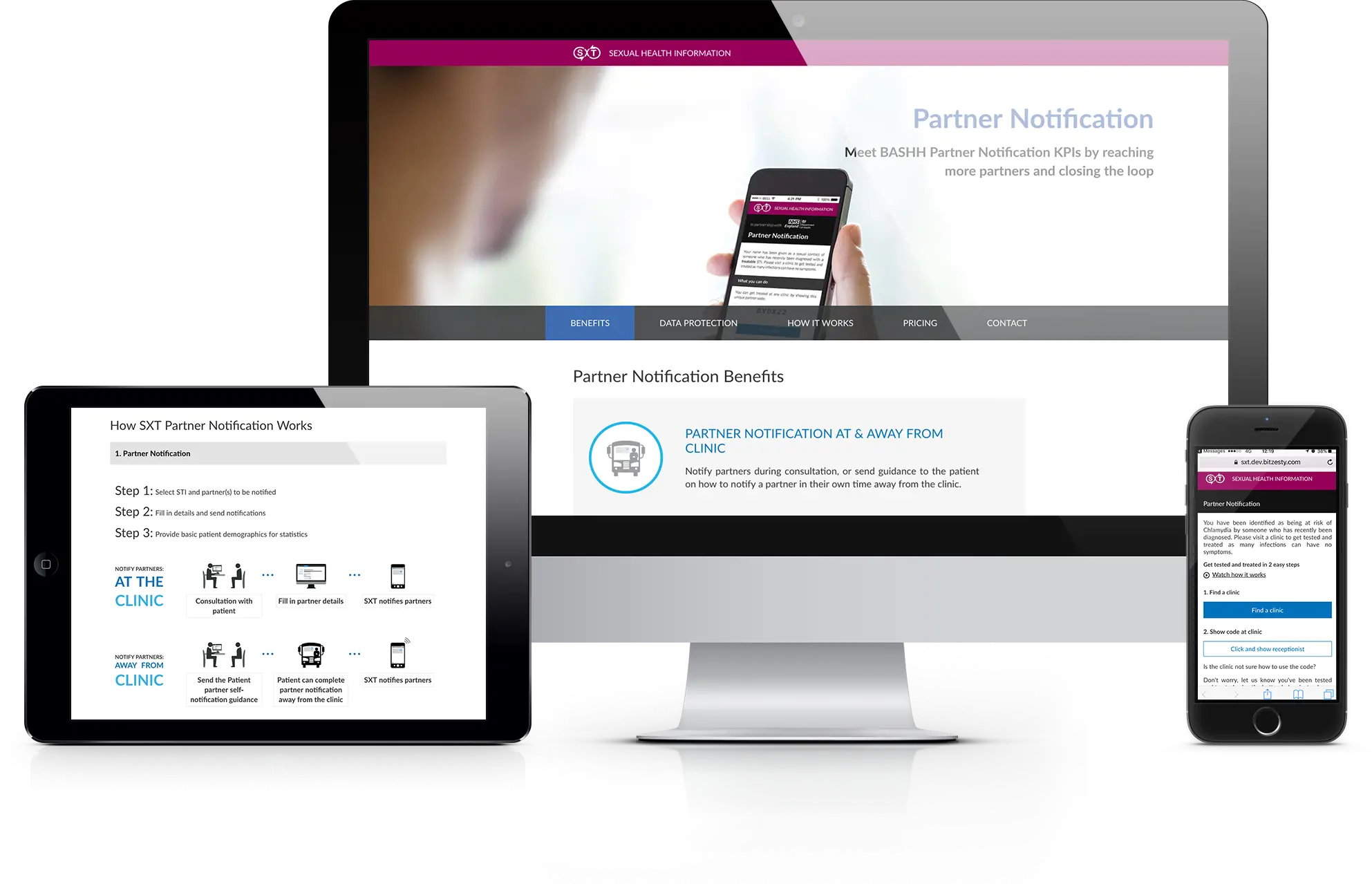THE BACKGROUND
When a patient is diagnosed with a sexually transmitted infection (STI), it’s important their partners are notified so that they can be tested and treated as well. Some patients feel too uncomfortable to tell their partners, and as a result sexual health clinics can’t always reach people who need treatment which leads to an increase in STI transmissions.
SXT is a social enterprise which works to make it easier for people to access sexual and reproductive health services. We built the digital platform SXT uses to deliver its other services, and they asked us to build a new service to improve partner notification rates and reduce the transmission of STIs.
PARTNER NOTIFICATION DIGITAL SERVICE
Bit Zesty developed a partner notification tool, carefully designed to be quick, easy and reassuring to use.
The tool allows patients, or their clinic, to anonymously notify partners. As patients can protect their identity, they are more willing to notify their partners, which reduces the transmission of STIs.
Partners receive a notification by SMS or email, which lets them know that they need to be tested and helps them find their nearest clinic. The partners’ details are deleted from the SXT system as soon as the notification message is sent.
The message sent to partners includes a code which any clinic can enter onto the SXT system. This enables the original patient’s clinic to easily track, and report on, the number of partners who get tested after receiving a notification from the tool.
USER-DRIVEN INNOVATION
To help SXT decide on the next addition to their digital platform, we wanted to understand their users’ most pressing needs. To do this, we carried out research with several key users in sexual health clinics.
After a number of telephone and face-to-face interviews with health professionals, it became clear that clinics were struggling to meet an important and challenging target: improving levels of partner notification in order to reduce the transmission of STIs.
A SERVICE DESIGNED AND TESTED BY USERS
We took an iterative approach to design and development.
We began by testing paper prototypes of the service with clinicians. We used their feedback to iterate the designs and rapidly develop a working prototype, which we then tested again with clinicians and healthcare workers.
Finally, the working software was tested with all user groups, including patients in clinic waiting rooms, who we successfully engaged, despite the sensitive nature of the subject.
This user-centered approach ensured we delivered a simple, intuitive solution which met the needs of both patients and health professionals.
BUILDING CONFIDENCE AND TRUST INTO THE SERVICE
For many people sexual health is a sensitive topic, so it was essential that the design of the tool made users feel confident and at ease.
Patients would only use the service if they trusted it completely. We made sure the tool’s design clearly signposted its strong confidentiality and privacy standards. We also highlighted the service’s partnership with the NHS and Department of Health, to increase trust.
MEASURING AND REPORTING IMPACT
From the beginning, being able to measure the tool’s impact was one of the key objectives.
With statistics on results, SXT can engage more clinics, support fundraising, and report to its board of trustees. The data is also vital for clinics which need to report on partner notification rates to the British Association of Sexual Health and HIV.
In addition, for us at Bit Zesty, this analytical data provides ongoing insight into user behaviour, allowing us to continuously improve the notification tool.
One clinic using the SXT service, Brighton Sexual Health and Contraception Service, improved their KPI for Gonorrhoea by 237% within four months of starting to use the Partner Notification Tool.
PROTECTING PATIENT DATA
Our biggest technical challenge was to make sure that patient data was kept confidential and secure.
To ensure patient confidentiality, data is anonymised and log files are permanently deleted. All patient records are encrypted using the same technology banks use to store credit card data and the military use for secure communications.










